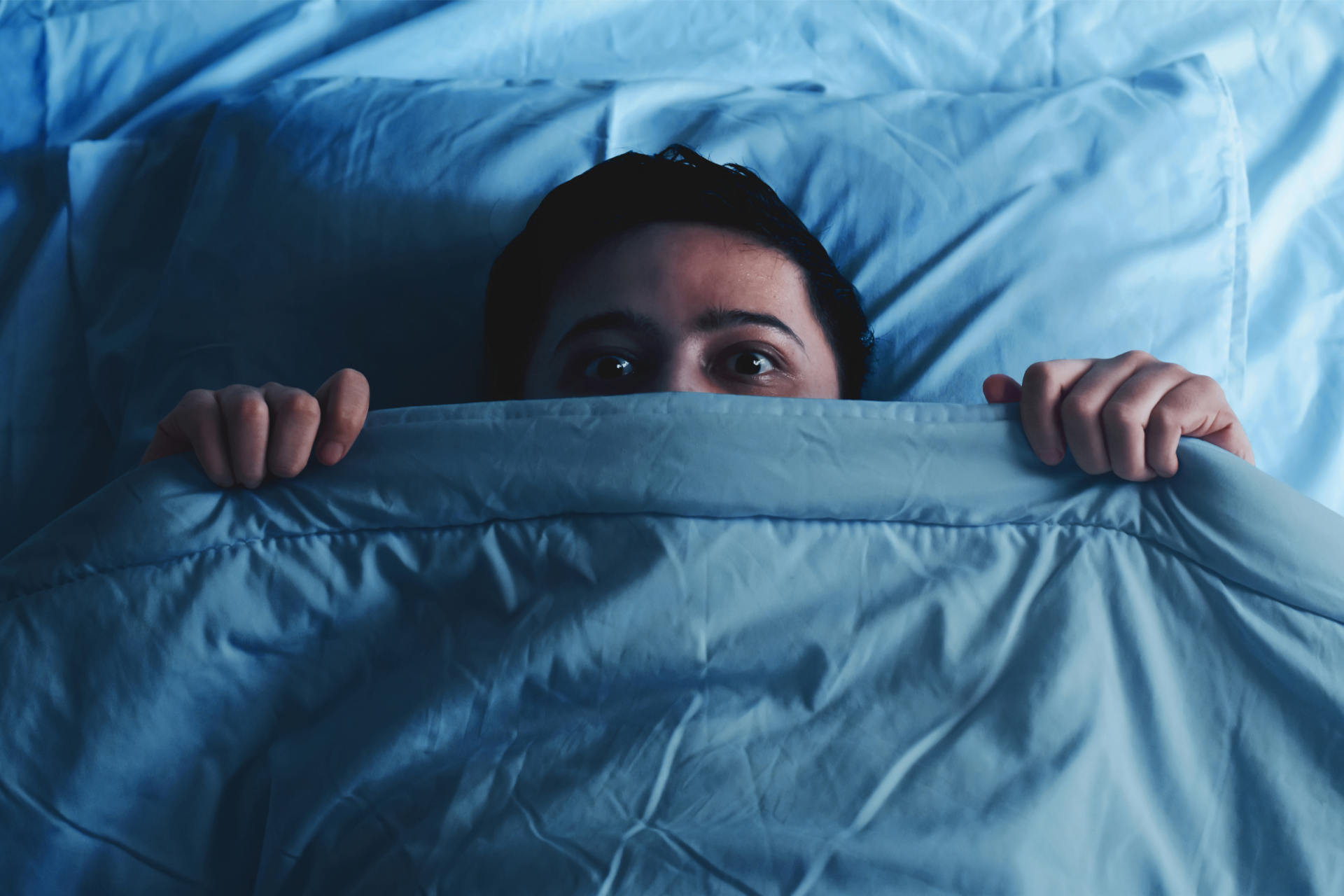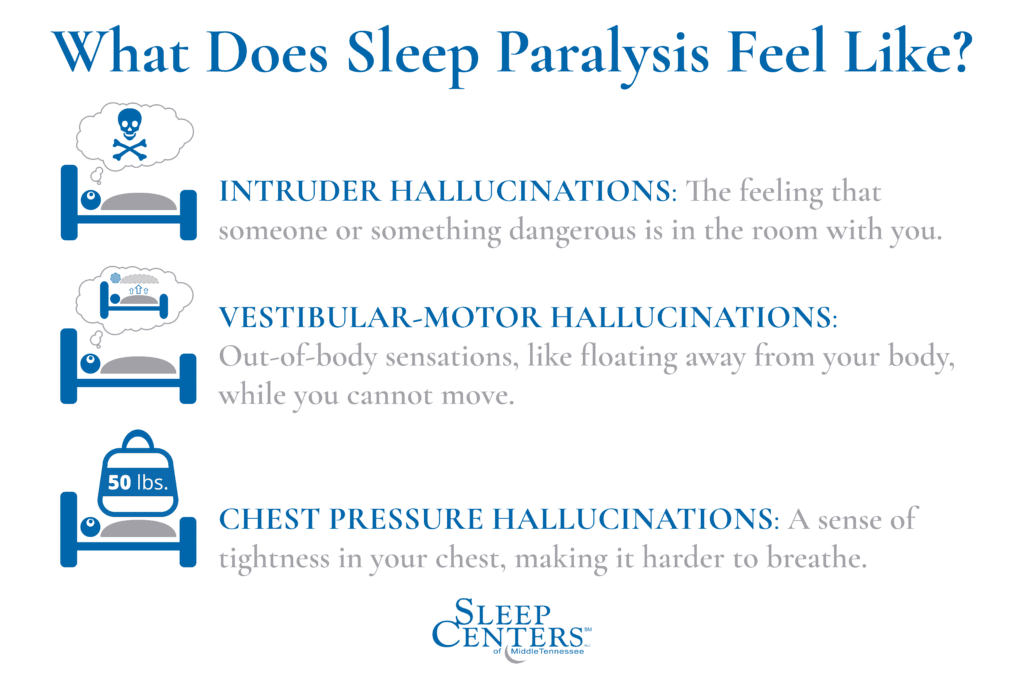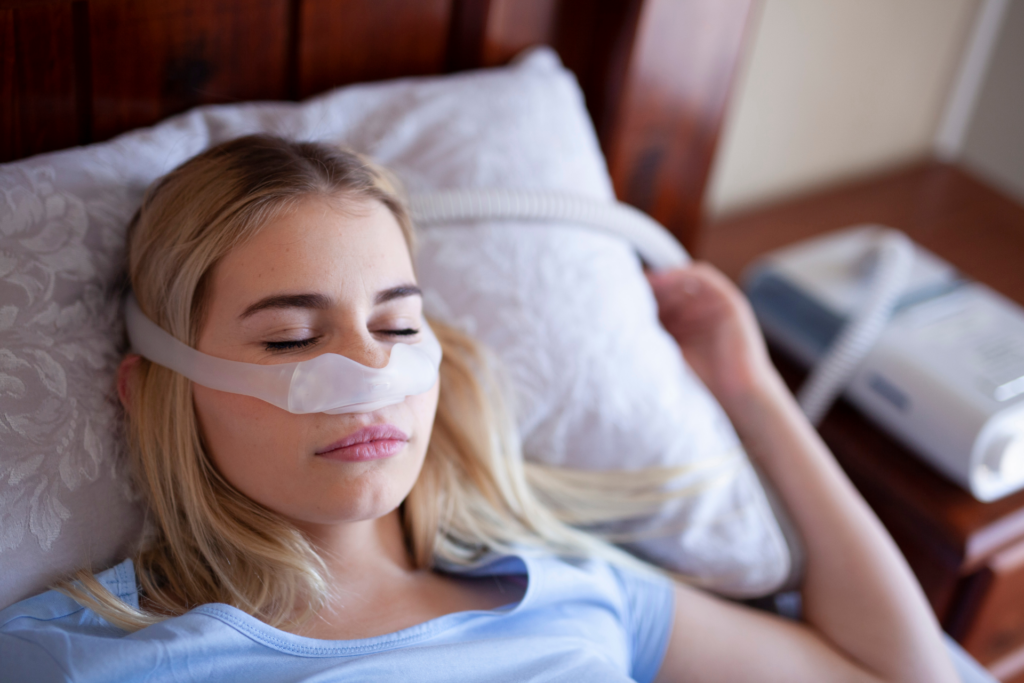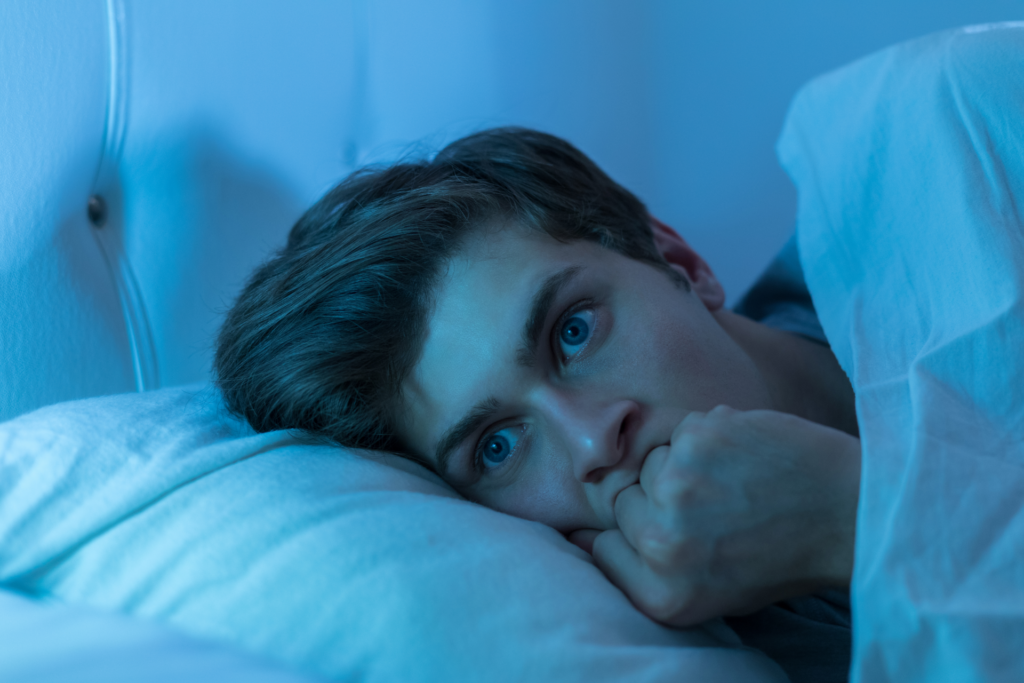Do you ever wake up from a nightmare only to find that you still can’t move, trapped in a state of paralysis? While sleep paralysis and sleep apnea aren’t mutually inclusive, there is a significant connection between the two sleep disorders that often go hand in hand.
Sleep paralysis may seem fiendish, like something Freddy Krueger would keep in his bag of tricks for terrorizing teenagers, but it is a real condition that can be quite spooky if you’ve ever experienced it.
Before you dismiss your spooky nighttime experiences as simply a nightmare, let’s explore the fascinating link between sleep paralysis and sleep apnea, and what you can do to finally get a peaceful night’s sleep.
First, let’s shed a little light on what sleep paralysis is and how to know if you have it.
What is Sleep Paralysis?
Sleep paralysis happens when the line between being asleep and being awake becomes blurred. It’s caused by a brief loss of muscle control, known as atonia.
A sleep paralysis episode begins either right after you fall asleep, or just before you wake up. During this time, you’re temporarily unable to move. In a way, you’re both awake and asleep during these episodes, which is why you remain aware the whole time.
This sense of awareness is what makes sleep paralysis a terrifying experience for people first experiencing it. Being unable to move or react is unsettling to say the least, especially if you’re fully aware of what’s happening. To make things all the more creepy, sleep paralysis episodes are often accompanied by unsettling side effects like a sense of feeling smothered, or even hallucinations. These delusions are created by your brain in an attempt to make sense of the unusual sensory input.
Sleep paralysis episodes are most associated with rapid eye movement or REM sleep, the sleep stage where your most vivid dreams take place. The atonia associated with sleep paralysis prevents you from acting out your dreams when you sleep, but it normally ends when you wake up so you’re never aware of your inability to move. Since sleep paralysis essentially combines your sleeping and waking states, in a way it crosses those wires and sends your body the wrong signals, making you experience both states at once.
There are two kinds of sleep paralysis:
- Isolated sleep paralysis: Like the name implies, these episodes are isolated incidents that are not connected to underlying sleep disorders like narcolepsy. Narcolepsy is a sleep disorder where your brain can’t control your states of wakefulness, which can often lead to sleep paralysis.
- Recurrent sleep paralysis: Where you experience multiple sleep paralysis episodes over time. Sometimes the two forms of sleep paralysis can overlap, causing Recurrent Isolated Sleep Paralysis (RISP).
Sleep paralysis is considered a parasomnia, or an abnormal behavior you experience during sleep. Other parasomnias include sleepwalking, sleep talking, and even night terrors. While sleep paralysis typically takes place during REM sleep, many other parasomnias occur during NREM sleep, a deep sleep stage where you’re less likely to realize these behaviors are taking place. [1]
Everyone experiences parasomnias at some point in their lives, but experiencing them regularly is a sign that something is amiss with your sleep.
What Does Sleep Paralysis Feel Like?
Sleep paralysis is a frightening experience for most. Besides being unable to move, additional sleep paralysis symptoms include:
- Intruder hallucinations, or believing that there is someone or something dangerous in the room with you.
- Vestibular-motor hallucinations, or out-of-body sensations while you are unable to move. This may feel like you are floating or flying away from your body.
- Chest pressure hallucinations. As the name implies, this hallucination creates a tightness in your chest that makes it difficult to breathe. Either kind of hallucination, or a combination of them, occurs with more than 70 percent of sleep paralysis episodes.
Sleep paralysis episodes can last anywhere from a few seconds to several minutes, and on average lasts for about 6-7 minutes. That’s a long time if you’re feeling scared and confused!
Experts are uncertain of the true cause sleep paralysis, but there have been strong correlations to other sleep disorders. We briefly mentioned narcolepsy above, but it’s not the only sleep disorder that can cause sleep paralysis.
If you’re familiar with our blog (or if you read the post’s title), you know where we’re going with this.
The Connection Between Sleep Paralysis and Sleep Apnea
Research has shown that there is a connection between sleep apnea and sleep paralysis. While sleep paralysis affects just 7 percent of the general population, 38 percent of observed obstructive sleep apnea patients experience sleep paralysis.
Sleep apnea is a sleep disorder that causes irregular breathing patterns during sleep. These irregular breathing patterns may include reductions in airflow (hypopneas, which are most common), or temporary cessation of breathing (apnea). These episodes can occur multiple times a night.
When a person experiences a hypopnea or apnea, the oxygen level in their body drops, and they may wake up gasping for air. This interrupted breathing pattern is also believed to be a contributing factor in causing sleep paralysis. Sleep paralysis is also common in people who experience nighttime leg cramps or restless legs syndrome, which also commonly occurs with sleep apnea.
Side effects associated with these irregular breathing patterns include loud snoring (snoring is the sound of hypopneas), gasping, or choking during sleep. These side effects can also coincide with sleep paralysis symptoms, particularly the chest pressure hallucinations that make it harder for you to breathe.
These symptoms contribute to a vicious cycle of sleep disturbance and daytime symptoms that only cause more sleep troubles and daytime sleepiness. The best way to treat these issues is with a good night’s sleep, which is far easier said than done if you have a sleep disorder.
The biggest takeaway you should be getting here is that sleep paralysis often accompanies other sleep disturbances and sleep disorders.
Common sleep apnea symptoms are also linked with sleep paralysis, such as:
- Insomnia, or difficulty falling asleep.
- Excessive daytime sleepiness caused by sleep deprivation or poor sleep quality.
- Mental health problems, such as depression or anxiety disorder. Sleep apnea can cause or contribute to these conditions because of how it affects your brain over time. Meanwhile, sleep paralysis can do the same because of the distressing nature of the disorder.
Thankfully, sleep apnea treatment can also help resolve any sleep paralysis you may be experiencing and help you get back to the healthy rest you need.
How to Treat Sleep Paralysis and Sleep Apnea Together
Thankfully, when it comes to treating the two, sleep apnea treatment can treat sleep paralysis as well. Two birds, one stone? Not quite. While treating sleep apnea can reduce sleep paralysis, it won’t prevent it entirely.
Unfortunately, neither condition can be permanently cured following treatment. That’s why it’s so important to treat them both and follow through for the duration; proper ongoing treatment reduces your sleep apnea and sleep paralysis symptoms, allowing you to get the good night’s sleep you need each night.
Here are our suggestions for treating sleep apnea while also helping banish sleep paralysis back to the realm of nightmares.
Try CPAP
CPAP, or continuous positive airway pressure, is the most commonly prescribed treatment for obstructive sleep apnea. That’s because it’s also the most effective treatment available since it prevents the airway obstructions that make it so hard to breathe in the first place. It can also help resolve sleep paralysis symptoms, like the scary sensation of not being able to breathe.
One study from the Journal of Neurology, Neurosurgery & Psychiatry has found that sleep paralysis can be a presenting symptom of obstructive sleep apnea, but oral appliance treatment for sleep apnea (like CPAP) resolved sleep paralysis symptoms in three patients! The study observed 15 patients who had sleep paralysis without narcolepsy. [2]
Practice Good Sleep Hygiene
Sleep hygiene is the term used to describe your sleep habits before bedtime, good or bad. Good sleep hygiene is instrumental to healthy sleep, and bad sleep hygiene can make it harder to get a good night’s rest. You may not realize it, but there is a lot that you may accidentally be doing to sabotage your sleep!
Here are some of our sleep hygiene tips to help you sleep well:
- Follow a consistent bedtime schedule. Going to bed at the same time each night and waking up at the same time each morning (even on weekends) helps prepare your body for being asleep or awake at your desired times.
- Practice relaxation techniques before bed, such as meditation or journaling. These help clear your mind and put it in a good place so you can fall asleep more readily.
- Avoid your electronic devices for at least an hour before bedtime. The blue light they emit can throw off your sleep cycle, delay sleep onset (making it harder for you to fall asleep), and cause disrupted sleep.
If you absolutely must use devices like your phone, tablet, TV, or computer before bedtime, blue light-blocking glasses or shields can help you get the sleep you need each night. We recommend the ones from OccuShield or Swanwick Sleep!
Exercise
Regular, moderate exercise can help you sleep better, whether it’s by helping you blow off steam or keeping your waistline trim.
Losing any extra weight can not only help prevent sleep apnea, but it can help reduce the severity of your symptoms if you already have the disorder.
In the study we referenced above, weight loss alone reduced the severity of sleep apnea symptoms in one participant and resolved their sleep paralysis entirely! [2]
Avoid Alcohol, Caffeine, and Nicotine Before Bed
All three recreational substances can wreak havoc on your sleep and worsen your sleep apnea symptoms if you’re not careful.
While alcohol is commonly used as a sleep aid, it actually harms your sleep more than it helps, especially if you have sleep apnea. Alcohol relaxes the muscles in your throat, obstructing your airways and making breathing difficult. To avoid this, stop consuming alcohol at least 3 to 4 hours before your regular bedtime.
For more information about alcohol’s effect on sleep, check out our article on the topic!
On the other end of the spectrum, caffeine is a stimulant. Of course, this is why so many people reach for that morning cup of coffee or tea to wake up! However, consuming caffeine too close to bedtime can make it much harder to get a good night’s sleep. Make sure to limit your caffeine consumption to at least 6 hours before bedtime. This gives your body plenty of time to process the caffeine and get it out of your system before you sleep.
Finally, we have nicotine. Nicotine, found in tobacco products like cigars, cigarettes, and vapes, as well as the smoke from these items, inflame your airways. To avoid this, avoid smoking at least a few hours before bed. However, quitting will be the best course of action to prevent nicotine from ruining your sleep. Even abstaining from smoking for as little as 3 days can improve your breathing and your lung function.
Sleep Problems Have You Scared Stiff? We Can Help!
Sleep paralysis may seem like the stuff of nightmares, but like any other sleep disorder, it can be controlled with the right treatment.
While sleep apnea symptoms can exacerbate sleep paralysis episodes, you are able to treat them both simply by using your CPAP machine.
If you are having frequent episodes of sleep paralysis, it might be a good idea to get tested for sleep apnea. Take our sleep apnea quiz to see if you’re at risk for the disorder. If you think you have the disorder or are at risk for it, it’s important to contact your doctor or a sleep specialist for an evaluation as soon as possible. Following the evaluation, they can help you get started on the right treatment option for your sleep needs.
Don’t let your sleep troubles fill you with fear. Contact us at the Sleep Centers of Middle Tennessee today to get the peaceful rest you deserve every night.
References
- “Parasomnias: Causes, Symptoms, Types & Management.” Cleveland Clinic, my.clevelandclinic.org/health/diseases/12133-parasomnias–disruptive-sleep-disorders.
- Leschziner, G, et al. “CP4 Isolated Sleep Paralysis as a Presenting Feature of Obstructive Sleep Apnoea.” BMJ Publishing Group Ltd, Journal of Neurology, Neurosurgery & Psychiatry, 1 Nov. 2010, jnnp.bmj.com/content/81/11/e34.3.




